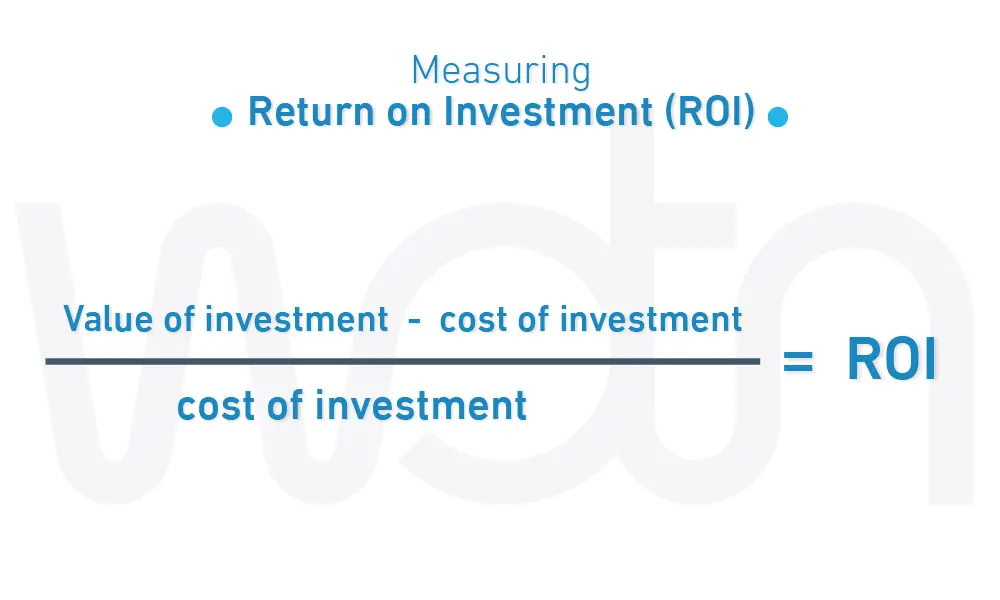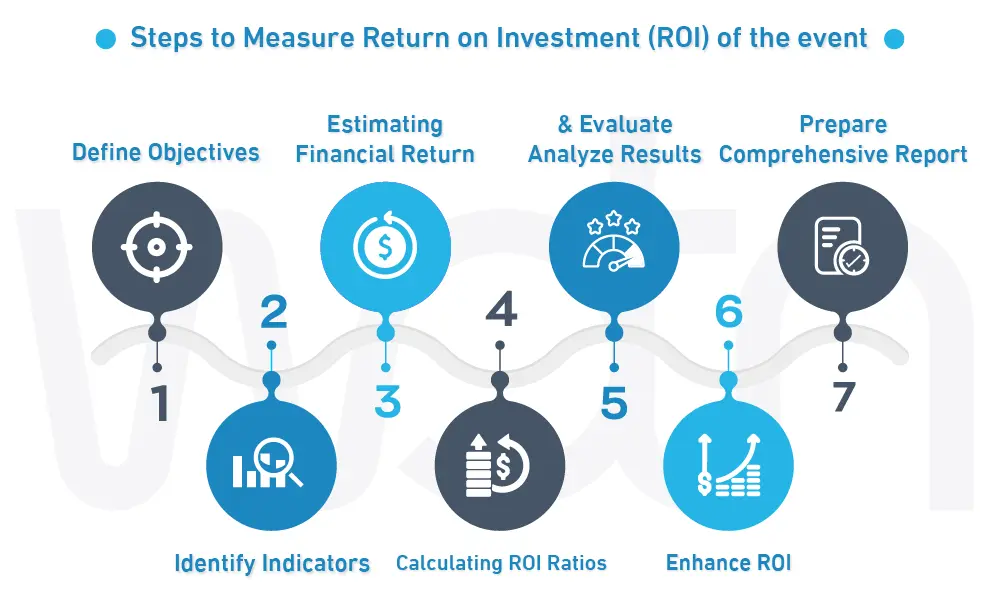Your Vision, Delivered
Say hello to the real experience!
Bring your next event to life—guided by experience, innovation, and excellence.
Let’s create together
Once you have successfully organizing your first event, and attaining substantial triumph, relishing commendatory feedback from participants, and experiencing a profound sense of pride and accomplishment for the exceptional work you've executed, a pivotal and indispensable phase ensues, culminating the cycle of your event's triumph. This is the moment for reflection and evaluation of the returns generated by this event, where you need to measure the benefits reaped from it. This is where the role of measuring Return on Investment of The Event (ROI) comes into play, clearly defining the actual value of the efforts you put into organizing the event.
Certainly, the importance of measuring Return on Investment (ROI) cannot be overstated. It functions as a critical instrument for assessing the actual worth of your endeavors. This metric clarifies the percentage of gains attained compared to the investments undertaken. It holds more significance than mere numerical value; it precisely gauges the efficiency of your resource utilization and how well it aligns with your established goals. So in this article, we will explore the concept and significance of Return on Investment, explaining measuring it using clear and uncomplicated steps.
It’s a precise process of extracting and analyzing data with the aim of evaluating the efficiency and achievement of an event. This measurement calculates the benefit gained from the event compared to the investment made, reflecting a balance between expenditure and returns.
When the percentage of Return on Investment (ROI) is estimated, organizers can assess the actual value of the event and its impact on business objectives and relationships. Through the analysis of this data, informed strategic decisions can be made that enhance the quality of future events and create a distinctive experience for participants.
Measuring an event's ROI serves as the cornerstone for realizing tangible shifts in the realms of planning and organization. It functions as a strategic compass, steering decisions toward sustainable triumph and ceaselessly innovating to amplify the worth of events.

Measuring an event's ROI holds paramount importance for both organizers and participants, offering a multitude of advantages:
After understanding the significance of measuring the Return on Investment (ROI) for an event, a crucial necessity arises: how can we calculate the net profit or benefit generated from the event? In reality, this process depends on the type, nature, and objectives of the event. Indicators and metrics used to measure the success and impact of events vary based on their audience and contribution. Some Types of Events may aim to boost sales or donations, enabling a direct measurement of their profits. Conversely, certain events may strive to raise awareness, influence, or bring about change, necessitating non-monetary indicators to gauge their effectiveness.
From this perspective, it becomes evident that indicators differ according to goals and target audiences. Despite these variations, there are fundamental steps that can be followed with precision to measure the ROI of an event professionally. These steps allow you to comprehensively assess your success in achieving both financial and non-monetary objectives, providing a clear insight into the event's overall accomplishment.

Defining the event's objectives is a crucial step in the measurement process. In this stage, it requires you to specify the outcomes you aim to achieve through organizing or participating in the event, and to also have a clear understanding of the criteria that will assess the degree of achieving these outcomes.
For instance, if your objective is to enhance sales through this event, you should define the desired sales value and pinpoint the quantity of potential customers you plan to engage. Alternatively, if your aim is to heighten awareness or realize a particular impact or transformation, you must establish the quantity of individuals you intend to reach with your message and comprehend the extent of engagement or influence you aspire to attain with them. In brief, your goals should harmonize with your business's vision, mission, and strategy. They should be specific, measurable, achievable, relevant, and time-bound (SMART).
Once you've defined your main objective, you begin to contemplate the necessary steps to achieve the desired outcome. This is where the process of identifying performance indicators and metrics for the event comes into play. Carefully selecting them enables you to gather data before, during, and after the event. Indicators are variables used to measure performance, such as the number of visitors, conversion rates, or satisfaction levels. Metrics, on the other hand, are the numbers used to quantify the values of those indicators, like 1000 visitors, a 10% conversion rate, or a satisfaction rating of 4 out of 5.
As such, indicators and metrics should be directly relevant to your objectives and be accurate, reliable, and easily collected and analyzed. Moreover, there are numerous sources that can be utilized to gather data, including surveys, Customer Relationship Management (CRM) systems, digital analytics tools, and social media platforms.
To calculate the net profit or benefit gained from an event, first, we need to subtract the cost of organizing the event from the total profit or benefit achieved through it. Simply put, in this plan, you will identify the overall costs related to the event by calculating all the expenses associated with it, such as registration fees, travel and accommodation costs, marketing and advertising, material and equipment expenses.
Conversely, you will assess the complete profit or benefits engendered by the event, encompassing sales revenues of products or services, contributions or funding, amplified clientele or followers, heightened awareness, impactful changes instigated by the event. Concerning the computation of costs and profits or benefits, the same measurement unit is employed, whether expressed in monetary terms, individuals, or percentages. Subsequently, the net profit or benefit can be determined by subtracting the total expenses from the overall profit or benefit realized.
You can calculate the Return on Investment (ROI) percentage for the event in a simple manner. First, you need to divide the net profit or benefit by the cost of the event, then multiply the result by 100. This step relies on the values calculated in the previous step. You can use the following formula: (Net Profit or Benefit / Cost of the Event) × 100 = ROI. For example, if you have a net profit from an event of $20,000 and its cost is $50,000, then the ROI percentage would be: ROI 40% = (20,000 / 50,000) × 100.
Also Read: A Guide To Choose The Right Speakers For Your Event
The most crucial step and phase come as evaluating and analyzing the results, comparing them to benchmarks, standards, or expectations. This stage requires you to compare the Return on Investment (ROI) calculated in the previous step with a set of indicators or metrics that contribute to assessing the success and viability of the event. There are various indicators and metrics that can be utilized in this evaluation:
Criteria are the initially set goals that represent the desired performance level. For instance, if your goal is to increase sales by 20%, this becomes the benchmark by which you assess the event's success. If the return on investment of The Event (ROI) exceeds 20%, it indicates the achievement or surpassing of the set goal. If it's lower, it signifies that the event didn't reach the expected performance level.
These reflect averages or measurements of ROI from events previously organized or participated in, serving to evaluate improvement or decline in the current event's performance. For example, if the average ROI from past events in the previous year was 30%, this serves as the reference rate for comparing the current event's ROI. If the ROI is higher than 30%, it implies an improvement in performance. If it's lower, it suggests a decline in performance.
These represent averages or measurements of ROI from events organized or participated in by other organizations, institutions, or individuals in the same field, industry, or market. They're used to assess competitiveness or compare against others. For instance, if the average ROI of your competitors' events in the market is 40%, this becomes the reference rate for comparing the ROI of your organized event. If your ROI is higher than 40%, it indicates outperforming your competitors. If it's lower, it indicates lagging behind them in performance.
Expectations reflect your estimated performance of the event before its execution. These expectations are based on your personal experience or information derived from research or expert consultations. For example, if you expect the anticipated event's ROI to be 50%, this expectation reflects the projected performance. If the actual ROI matches the expectations, it demonstrates the realization of what was anticipated. If it's higher, it indicates exceeding expectations, and if it's lower, it signals not meeting the expectations.
This stage holds its significance in devising appropriate actions and recommendations to enhance the return on investment (ROI) in future events. It requires you to base your decisions on the preceding results and analyses. This step is aimed at empowering you to make informed and justified choices, ultimately seeking to increase the feasibility of future investments. Here are some potential actions and recommendations:
It's worth noting that analyzing the reasons and factors that impacted the ROI can help identify strengths and weaknesses, thus reinforcing positive aspects and addressing areas in need of improvement. Once areas for enhancement are identified, efforts can be directed towards implementing appropriate improvements and adjusting strategies accordingly.
This step requires you to prepare a thorough, unbiased, and professional report that covers several important aspects. The report should include a presentation of the return on investment (ROI) for the event, along with an explanation and analysis of the factors and reasons that influenced this ratio. Furthermore, the report encompasses the actions and recommendations that have been taken or will be taken to enhance the investment viability in future events.
Moreover, it is important that the report's details are organized and engaging, utilizing an appropriate format. This includes the cover, content, introduction, objectives, methodology, results, analysis, conclusions, recommendations, and references.
In conclusion, it becomes apparent that measuring return on investment of The Event (ROI) serves as a powerful tool that provides profound insights and a comprehensive understanding of the value of efforts and investments made in an event. Utilizing realistic and meticulously studied data enhances understanding and communication among various stakeholders, guiding you towards making informed and effective decisions regarding the future of these events. If you are seeking further information in the field of event management and organization, we encourage you to continue following us for ongoing tips and guidance on achieving remarkable success in this dynamic and impactful realm.
Say hello to the real experience!
Bring your next event to life—guided by experience, innovation, and excellence.
Let’s create together
